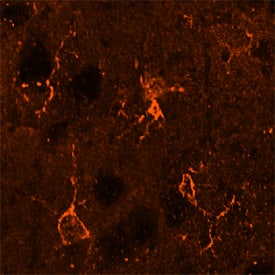Mouse/Rat Integrin beta5 Antibody
R&D Systems, part of Bio-Techne | Catalog # AF8035

Key Product Details
Species Reactivity
Validated:
Cited:
Applications
Validated:
Cited:
Label
Antibody Source
Product Specifications
Immunogen
Gly24-Asn719
Accession # NP_001139356
Specificity
Clonality
Host
Isotype
Scientific Data Images for Mouse/Rat Integrin beta5 Antibody
Detection of Mouse and Rat Integrin beta5 by Western Blot.
Western blot shows lysates of CMT-93 mouse rectal carcinoma cell line and C6 rat glioma cell line. PVDF membrane was probed with 1 µg/mL of Sheep Anti-Mouse Integrin beta5 Antigen Affinity-purified Polyclonal Antibody (Catalog # AF8035) followed by HRP-conjugated Anti-Sheep IgG Secondary Antibody (Catalog # HAF016). A specific band was detected for Integrin beta5 at approximately 95 kDa (as indicated). This experiment was conducted under reducing conditions and using Immunoblot Buffer Group 1.Detection of Integrin beta5 in bEnd.3 Mouse Cell Line by Flow Cytometry.
bEnd.3 mouse endothelioma cell line was stained with Sheep Anti-Mouse/Rat Integrin beta5 Antigen Affinity-purified Polyclonal Antibody (Catalog # AF8035, filled histogram) or isotype control antibody (Catalog # 5-001-A, open histogram), followed by Allophycocyanin-conjugated Anti-Sheep IgG Secondary Antibody (Catalog # F0127).Integrin beta5 in Mouse Brain.
Integrin beta5 was detected in perfusion fixed frozen sections of mouse brain using Sheep Anti-Mouse/Rat Integrin beta5 Antigen Affinity-purified Polyclonal Antibody (Catalog # AF8035) at 15 µg/mL overnight at 4 °C. Tissue was stained using the Northern-Lights™ 557-conjugated Anti-Sheep IgG Secondary Antibody (red; Catalog # NL010). Specific staining was localized to glial cells. View our protocol for Fluorescent IHC Staining of Frozen Tissue Sections.Applications for Mouse/Rat Integrin beta5 Antibody
CyTOF-ready
Flow Cytometry
Sample: bEnd.3 mouse endothelioma cell line
Immunohistochemistry
Sample: Perfusion fixed frozen sections of mouse brain
Western Blot
Sample: CMT‑93 mouse rectal carcinoma cell line and C6 rat glioma cell line
Formulation, Preparation, and Storage
Purification
Reconstitution
Formulation
Shipping
Stability & Storage
- 12 months from date of receipt, -20 to -70 °C as supplied.
- 1 month, 2 to 8 °C under sterile conditions after reconstitution.
- 6 months, -20 to -70 °C under sterile conditions after reconstitution.
Background: Integrin beta 5
The beta5 integrin is a 95-110 kDa member of the integrin beta chain family, integrin superfamily of molecules. It is expressed by select cell types, including microglia, keratinocytes, fibroblasts, endothelial cells, adhesive monocytes and macrophages, retinal pigment epithelium, immature dendritic cells and colonic epithelium. The Integrin beta5 subunit forms a noncovalent heterodimer with the alphav integrin subunit, and together they bind vitronectin, and the Thy-1 antigen. alphav beta5 is reported to participate in phagocytosis, and act in concert with CD81, CD36 and stabilin-2 on the cell surface. When alphav beta5 binds Thy-1, the heterodimer apparently interfers with cell membrane activation of TGF-beta. Intracellularly, it appears to regulate actin skeleton remodeling via focal adhesion complex formation, and may contribute to cryptic pathways associated with antigen presentation. Mature mouse Integrin beta5 is a 775 amino acid (aa) type I transmembrane glycoprotein that contains a 696 aa extracellular domain (ECD) (aa 24-719) and a 56 aa cytoplasmic region. The ECD contains a 243 aa vWF-A domain (aa 136-378) and a Cys-rich tandem repeat region (aa 465-630). There is one splice variant that shows a 57 aa substitution for aa 760-798. This splice form does not appear to be expressed by the human Integrin beta5 gene. Over aa 24-719, mouse Integrin beta5 shares 91% and 97% aa sequence identity with human and rat Integrin beta5, respectively.
Alternate Names
Gene Symbol
UniProt
Additional Integrin beta 5 Products
Product Documents for Mouse/Rat Integrin beta5 Antibody
Product Specific Notices for Mouse/Rat Integrin beta5 Antibody
For research use only


